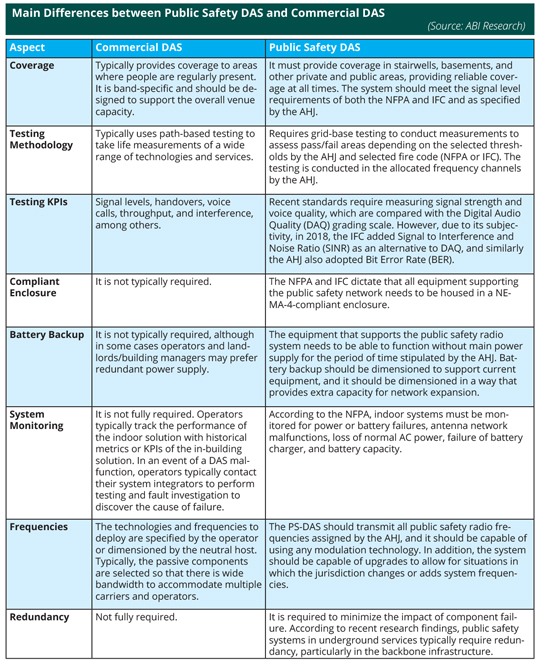1Q 2021 | IN-6086
Registered users can unlock up to five pieces of premium content each month.
The Deployment Challenge |
NEWS |
With the transition of the different cellular technologies and the high increase in data consumption both indoors and outdoors, optical fiber has become an important infrastructure element able to support multiple services such as Wi-Fi, surveillance cameras, and as a transport layer for Distributed Antenna Systems (DAS). In the United States, building owners are facing the challenge of deploying Public Safety DAS (PS-DAS) when it is mandated by the Authorities Having Jurisdictions (AHJ). For this purpose, multiple in-building solutions can be adopted, such as repeaters, passive DAS, and active DAS where the equipment and labor cost of the PS-DAS is typically assumed by the landlords. In the installation phase, the building is provisioned with power supply and cable trays as well as vertical and horizontal cabling, all of which can be leveraged for a better wireless business case. Thus, landlords could take this situation as an opportunity to give extra value to the building rather than looking for the quickest way to “fix the issue” and meet the requirements allocated by the AHJ.
Once landlords have embarked on the in-building wireless project, they should think ahead in order to make the most of the upfront investment to realize a wireless connected building. With this approach, building owners will be in a position not only to provide a safer building for first responders and its occupants, but also value-added features for competitive advantage.
Public Safety DAS versus Commercial DAS |
IMPACT |
Currently, many PS-DAS systems are being deployed as standalone solutions, meaning that the wireless infrastructure can be used for first responders’ purposes only. This includes cabling and antennas as well as passive and active equipment. PS-DAS and commercial DAS can be thought of as very similar solutions. However, there are several factors that make them different. These differences are mainly summarized in the table below:

The Potential Way Forward for Building Owners |
RECOMMENDATIONS |
It is true that by deploying a PS-DAS, building owners improve the safety of their occupants and first responders. However, this does not necessarily mean that the public will be able to establish communication with the exterior in the event of an emergency. Typically, PS-DAS in North America is tuned to deploy VHF, UHF, 700 MHz narrow band, and 800 MHz frequency bands as specified by the AHJ. Therefore, there is no guarantee that the building will have good commercial cellular coverage.
Due to the clear differences stated in the previous table, the survivability of the PS-DAS makes it different from a commercial DAS, and therefore ABI Research expects that these systems should be kept as two parallel solutions. However, the labor and infrastructure such as fiber, power distribution, and pre-installed cable trays can be leveraged for the deployment of a commercial DAS solution and other digital services. Hence, in the case of a new building, building owners have an advantage to establish an early engagement with AHJ, neutral host provider, system integrator, or Mobile Network Operator (MNO) to pre-plan for the deployment of a cellular DAS system. With this approach, landlords will make the most of the labor required on site and thus provision the building with the appropriate backbone capacity, power requirements, cable paths, and adequate space for vertical and horizontal cabling along with a suitable capacity in terms of space and power in the main equipment room. The correct dimensioning of the infrastructure will enable building owners to deliver a PS-DAS, but also to have a multidimensional wireless infrastructure for cellular services, Wi-Fi, and why not a fully digital connected building?
However, building owners should look for technical advice from professional and experienced system integrators, neutral hosts, and AHJ for the design and deployment of effective public safety and commercial DAS solutions. Errors in the design can lead to interference issues, generated from the exterior and from the commercial cellular deployment, thus jeopardizing the correct performance of both solutions and compromising the safety of the building occupants and first responders.